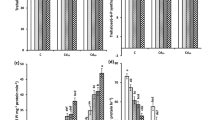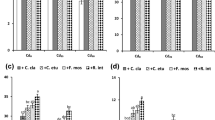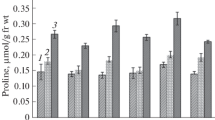Abstract
Arbuscular mycorrhizal (AM) fungi have been used to alleviate heavy metal stress on plant growth and uptake of micro- and macroelements. A greenhouse pot experiment was conducted to verify the effects of AM fungus Rhizophagus irregularis on the growth, physiological characteristics, total Cd, and element uptake of Phragmites australis under different Cd stress (in the range of 0–20 mg L−1). The results showed that the symbiosis could effectively alleviate Cd toxicity with greater root biomass, higher photosynthesis rate, and lower levels of malonaldehyde (MDA) and proline than non-mycorrhizal plants could. However, reduced transpiration rate (Tr) and stomatal conductance (g s) indicated R. irregularis protected host plants from Cd stress (≥5 mg L−1) via the stomatal closure. Although micro- and macroelements displayed differently in the presence of Cd, higher concentrations were still detected in mycorrhizal plants in contrast to non-mycorrhizal plants. Moreover, step multiple regression significantly demonstrated Pnmax, stem diameter (Sd), and g s were the important factors with regard to total Cd uptake in the symbiosis, but Mn affected to non-mycorrhizal plants. These results suggested R. irregularis could alleviate the competition between Mn and Cd by altering plant physiology. This work clearly demonstrated that R. irregularis can be able to support P. australis growth better even though under high Cd stress (>1 mg L−1), suggesting its good potential for practical use in high Cd-contaminated areas.






Similar content being viewed by others
References
Ågren GI, Weih M (2012) Plant stoichiometry at different scales: element concentration patterns reflect environment more than genotype. New Phytol 194:944–952
Arias JA et al (2010) Plant growth and metal distribution in tissues of Prosopis juliflora-velutina grown on chromium contaminated soil in the presence of Glomus deserticola. Environmental Science & Technology 44:7272–7279
Bates L, Waldren R, Teare I (1973) Rapid determination of free proline for water-stress studies. Plant Soil 39:205–207
Burzyński M, Żurek A (2007) Effects of copper and cadmium on photosynthesis in cucumber cotyledons. Photosynthetica 45:239–244
Bush J (2008) The potential role of mycorrhizae in the growth and establishment of Juniperus seedlings. In: Western North American Juniperus Communities. Springer, p 111–130
Chen B, Christie P, Li X (2001) A modified glass bead compartment cultivation system for studies on nutrient and trace metal uptake by arbuscular mycorrhiza. Chemosphere 42:185–192
Chiu K, Ye Z, Wong M (2006) Growth of Vetiveria zizanioides and Phragmities australis on Pb/Zn and Cu mine tailings amended with manure compost and sewage sludge: a greenhouse study. Bioresour Technol 97:158–170
De la Rosa G, Martínez-Martínez A, Pelayo H, Peralta-Videa JR, Sanchez-Salcido B, Gardea-Torresdey JL (2005) Production of low-molecular weight thiols as a response to cadmium uptake by tumbleweed (Salsola kali). Plant Physiol Biochem 43:491–498
Dutt S, Sharma SD, Kumar P (2013) Arbuscular mycorrhizas and Zn fertilization modify growth and physiological behavior of apricot (Prunus armeniaca L.). Sci Hortic 155:97–104
Ederli L, Reale L, Ferranti F, Pasqualini S (2004) Responses induced by high concentration of cadmium in Phragmites australis roots. Physiol Plant 121:66–74
Farquhar GD, Sharkey TD (1982) Stomatal conductance and photosynthesis. Annu Rev Plant Physiol 33:317–345
Gao Y, Cheng Z, Ling W, Huang J (2010) Arbuscular mycorrhizal fungal hyphae contribute to the uptake of polycyclic aromatic hydrocarbons by plant roots. Bioresour Technol 101:6895–6901
Gardea-Torresdey J, Peralta-Videa J, Montes M, De la Rosa G, Corral-Diaz B (2004) Bioaccumulation of cadmium, chromium and copper by Convolvulus arvensis L.: impact on plant growth and uptake of nutritional elements. Bioresour Technol 92:229–235
Garg N, Bhandari P (2014) Cadmium toxicity in crop plants and its alleviation by arbuscular mycorrhizal (AM) fungi: an overview. Plant Biosystems-An International Journal Dealing with all Aspects of Plant Biology 148:609–621
Garg N, Chandel S (2012) Role of arbuscular mycorrhizal (AM) fungi on growth, cadmium uptake, osmolyte, and phytochelatin synthesis in Cajanus cajan (L.) Millsp. under NaCl and Cd stresses. J Plant Growth Regul 31:292–308
Guerinot ML (2000) The ZIP family of metal transporters. Biochimica et Biophysica Acta (BBA)-Biomembranes 1465:190–198
Gums JG (2004) Magnesium in cardiovascular and other disorders. Am J Health Syst Pharm 61:1569–1576
Hassan SE, Hijri M, St-Arnaud M (2013) Effect of arbuscular mycorrhizal fungi on trace metal uptake by sunflower plants grown on cadmium contaminated soil. New Biotechnol 30:780–787
Hernández LE, Lozano-Rodrıguez E, Gárate A, Carpena-Ruiz R (1998) Influence of cadmium on the uptake, tissue accumulation and subcellular distribution of manganese in pea seedlings. Plant Sci 132:139–151
Hu J, Wang H, Wu F, Wu S, Cao Z, Lin X, Wong MH (2014) Arbuscular mycorrhizal fungi influence the accumulation and partitioning of Cd and P in bashfulgrass (Mimosa pudica L.) grown on a moderately Cd-contaminated soil. Appl Soil Ecol 73:51–57
Janoušková M, Pavlíková D, Vosátka M (2006) Potential contribution of arbuscular mycorrhiza to cadmium immobilisation in soil. Chemosphere 65:1959–1965
Jiang X, Wang C (2008) Zinc distribution and zinc-binding forms in Phragmites australis under zinc pollution. J Plant Physiol 165:697–704
Kaldorf M, Kuhn A, Schröder W, Hildebrandt U, Bothe H (1999) Selective element deposits in maize colonized by a heavy metal tolerance conferring arbuscular mycorrhizal fungus. J Plant Physiol 154:718–728
Kapoor R, Sharma D, Bhatnagar A (2008) Arbuscular mycorrhizae in micropropagation systems and their potential applications. Sci Hortic 116:227–239
Lagerwerff J, Biersdorf G (1972) Interaction of zinc with uptake and translocation of cadmium in radish. Trace Subst Environ Health; (United States) 5
Leite HAC, Silva AB, Gomes FP, Gramacho KP, Faria JC, de Souza JT, Loguercio LL (2013) Bacillus subtilis and Enterobacter cloacae endophytes from healthy Theobroma cacao L. trees can systemically colonize seedlings and promote growth. Appl Microbiol Biotechnol 97:2639–2651
Liu J et al (2003) Correlations between cadmium and mineral nutrients in absorption and accumulation in various genotypes of rice under cadmium stress. Chemosphere 52:1467–1473
Liu L-Z, Gong Z-Q, Zhang Y-L, Pei-Jun L (2011) Growth, cadmium accumulation and physiology of marigold (Tagetes erecta L.) as affected by arbuscular mycorrhizal fungi. Pedosphere 21:319–327
Liu L, Gong Z, Zhang Y, Li P (2014) Growth, cadmium uptake and accumulation of maize (Zea mays L.) under the effects of arbuscular mycorrhizal fungi. Ecotoxicology 23:1979–1986
Liu Y, Zeng G, Wang X, Chen B, Song H, Xu L (2010) Cadmium accumulation in Vetiveria zizanioides and its effects on growth, physiological and biochemical characters. Bioresour Technol 101:6297–6303
Marrs KA, Walbot V (1997) Expression and RNA splicing of the maize glutathione S-transferase Bronze2 gene is regulated by cadmium and other stresses. Plant Physiol 113:93–102
Miransari M (2011) Hyperaccumulators, arbuscular mycorrhizal fungi and stress of heavy metals. Biotechnol Adv 29:645–653
Oliveira R, Dodd J, Castro P (2001) The mycorrhizal status of Phragmites australis in several polluted soils and sediments of an industrialised region of Northern Portugal. Mycorrhiza 10:241–247
Osmond C (1994) What is photoinhibition? Some insights from comparisons of shade and sun plants. Photoinhibition of photosynthesis from molecular mechanisms to the field
Pedranzani H, Rodríguez-Rivera M, Gutiérrez M, Porcel R, Hause B, Ruiz-Lozano J (2015) Arbuscular mycorrhizal symbiosis regulates physiology and performance of Digitaria eriantha plants subjected to abiotic stresses by modulating antioxidant and jasmonate levels. Mycorrhiza 26:141–152
Pietrini F, Iori V, Bianconi D, Mughini G, Massacci A, Zacchini M (2015) Assessment of physiological and biochemical responses, metal tolerance and accumulation in two eucalypt hybrid clones for phytoremediation of cadmium-contaminated waters. J Environ Manag 162:221–231
Rocha ACS, Almeida CMR, Basto MCP, Vasconcelos MTS (2014a) Phragmites australis response to Cu in terms of low molecular weight organic acids (LMWOAs) exudation: influence of the physiological cycle. Estuar Coast Shelf Sci 146:76–82
Rocha ACS, Almeida CMR, Basto MCP, Vasconcelos MTSD (2014b) Antioxidant response of Phragmites australis to Cu and Cd contamination. Ecotoxicol Environ Saf 109:152–160. doi:10.1016/j.ecoenv.2014.06.027
Roth U, von Roepenack-Lahaye E, Clemens S (2006) Proteome changes in Arabidopsis thaliana roots upon exposure to Cd2+. J Exp Bot 57:4003–4013
Roumet C, Urcelay C, Diaz S (2006) Suites of root traits differ between annual and perennial species growing in the field. New Phytol 170:357–368
Sharma SS, Dietz K-J (2006) The significance of amino acids and amino acid-derived molecules in plant responses and adaptation to heavy metal stress. J Exp Bot 57:711–726
Silva S, Pinto G, Santos C (2016) Low doses of Pb affected Lactuca sativa photosynthetic performance. Photosynthetica 1–9. doi:10.1007/s11099-016-0220-z
Smith FA (2000) Measuring the influence of mycorrhizas. New Phytol 148:4–6
Smith SE, Smith FA, Jakobsen I (2004) Functional diversity in arbuscular mycorrhizal (AM) symbioses: the contribution of the mycorrhizal P uptake pathway is not correlated with mycorrhizal responses in growth or total P uptake. New Phytol 162:511–524
Sun Y, Li Y, Xu Y, Liang X, Wang L (2015) In situ stabilization remediation of cadmium (Cd) and lead (Pb) co-contaminated paddy soil using bentonite. Appl Clay Sci 105:200–206
Tian H, Cheng K, Wang Y, Zhao D, Lu L, Jia W, Hao J (2012) Temporal and spatial variation characteristics of atmospheric emissions of Cd, Cr, and Pb from coal in China. Atmos Environ 50:157–163
Veresoglou SD, Menexes G, Rillig MC (2012) Do arbuscular mycorrhizal fungi affect the allometric partition of host plant biomass to shoots and roots? A meta-analysis of studies from 1990 to 2010. 22
Vogel-Mikuš K, Pongrac P, Kump P, Nečemer M, Regvar M (2006) Colonisation of a Zn, Cd and Pb hyperaccumulator Thlaspi praecox Wulfen with indigenous arbuscular mycorrhizal fungal mixture induces changes in heavy metal and nutrient uptake. Environ Pollut 139:362–371
Wang M, Zou J, Duan X, Jiang W, Liu D (2007) Cadmium accumulation and its effects on metal uptake in maize (Zea mays L.). Bioresour Technol 98:82–88
Webster SM, del Camino D, Dekker JP, Yellen G (2004) Intracellular gate opening in Shaker K+ channels defined by high-affinity metal bridges. Nature 428:864–868
Wright D, Scholes J, Read D (1998) Effects of VA mycorrhizal colonization on photosynthesis and biomass production of Trifolium repens L. Plant Cell Environ 21:209–216
Wu H, Zhang J, Li P, Zhang J, Xie H, Zhang B (2011) Nutrient removal in constructed microcosm wetlands for treating polluted river water in northern China. Ecol Eng 37:560–568
Wu J, Ma F, Wang L, Yang J, Huang X, An G, Liu S (2014) Seedling performance of Phragmites australis (Cav.) Trin ex. Steudel in the presence of arbuscular mycorrhizal fungi. J Appl Microbiol 116:1593–1606
Wu Q-S, Zou Y-N, He X-H (2010) Contributions of arbuscular mycorrhizal fungi to growth, photosynthesis, root morphology and ionic balance of citrus seedlings under salt stress. Acta Physiol Plant 32:297–304
Zhao S, Lian F, Duo L (2011) EDTA-assisted phytoextraction of heavy metals by turfgrass from municipal solid waste compost using permeable barriers and associated potential leaching risk. Bioresour Technol 102:621–626
Acknowledgments
The authors gratefully acknowledge the Major Science and Technology Program for Water Pollution Control and Treatment (2012ZX07201003) and the National Natural Science Foundation of China (31570505). This study was also supported by the State Key Laboratory of Urban Water Resource and Environment, Harbin Institute of Technology (2014TS05).
Author information
Authors and Affiliations
Corresponding authors
Additional information
Responsible editor: Elena Maestri
Electronic supplementary material
Table S1
(DOCX 22 kb)
Rights and permissions
About this article
Cite this article
Wang, L., Huang, X., Ma, F. et al. Role of Rhizophagus irregularis in alleviating cadmium toxicity via improving the growth, micro- and macroelements uptake in Phragmites australis . Environ Sci Pollut Res 24, 3593–3607 (2017). https://doi.org/10.1007/s11356-016-7984-3
Received:
Accepted:
Published:
Issue Date:
DOI: https://doi.org/10.1007/s11356-016-7984-3




